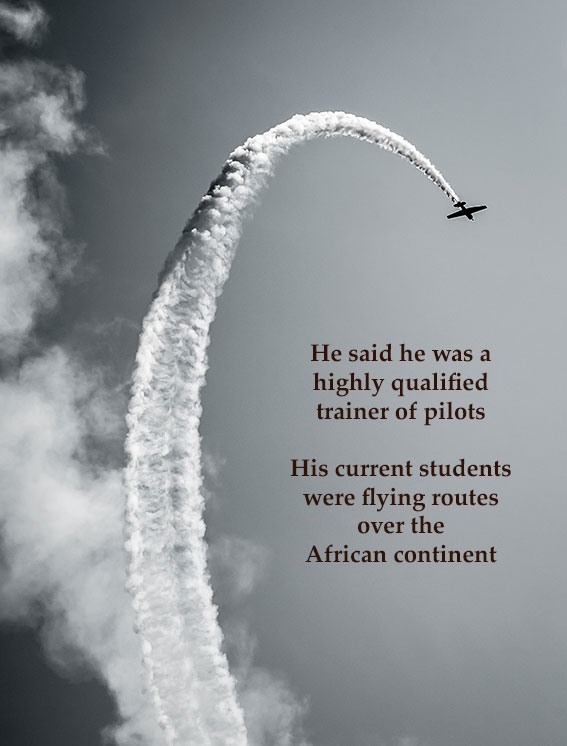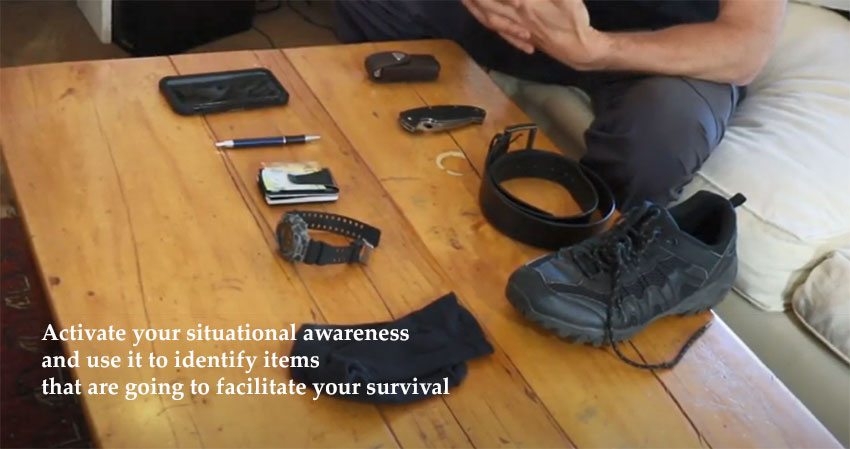Ok, I admit it. I had a few too many drinks the night before. That, and also, well, I needed the money. When you need money you end up doing things you won’t ordinarily do.
How was I going to get out of this one?

He said he was a highly qualified trainer of pilots. His current students were flying routes over the African continent. Survival skills training? Sure I could give them some survival training. No problem.
The next morning I woke up with a headache. I got in touch with a mentor of mine. He had spent 17 years in the military. He put me in touch with a special forces survival instructor for some advice.
Three weeks?! I couldn’t do a three-week presentation! All I had was 45 minutes.
Definition of opportunistic: exploiting immediate opportunities, especially regardless of planning or principle.
At the time I was reading a book about British explorer Sir Ernest Shackleton. Shackleton’s story is an extraordinary tale of survival and endurance. In an attempt to reach the South Pole, he and his crew had lost their ship to ice flows and were able to survive for over a year in one of the harshest environments on the planet. The story is often featured in leadership studies. I was impressed by Shackleton’s way of thinking and the brilliant leadership of his crew.
This got me thinking. What makes someone a survivor?
I thought about this for a while. In a quiet moment, it hit me all at once. When inspiration hits, I always go with it. I suddenly knew how I was going to give a 45-minute presentation.
It occurred to me that the key to his success was his survival mindset.
Table of Contents
It’s all about Survival Mindset
There are thousands of stories of survival, in some cases, the people are trained and equipped for survival, like SAS soldier Chris Ryan. In an extraordinary military story, Ryan survived a 180-mile solitary walk across hostile Iraqi territory into Syria.

Other stories are about everyday people like Rose Schindler. In 1944, Schindler and her family were sent to the Nazi death camp Auschwitz. Rose was 14 years old at the time, she and her sisters had no training or resources, or so it seemed. Rose survived one of history’s worst atrocities by blending into the environment and slipping away from the lines to the gas chamber. She managed to do this on more than one occasion. Rose was starved and sick, and yet even within these most deplorable circumstances, she, and her sisters were able to use some guile, resourcefulness, and an unshakable sense of hope to keep themselves alive. It seems that the most important resources are firstly found inside of you, and then from what is around you. The question is can we activate your inner resource button?
Resourcefulness – Survival Exercise
There was no time to present any survival skills to the pilots, but maybe I could create a process that explored the mindset required to survive. To do this I created an exercise inspired by Tom Hank’s movie Cast Away.

Try this exercise at home as I explain it. In Cast Away, courier guy Chuck Nolan is marooned on a tropical island after he survives a plane crash. Now imagine you are in Chuck Nolan’s situation. You drag yourself onto the beach, collapse on the sand, and take stock of your situation. What resources do you have on you? v. You are going to need water, food, shelter maybe something to defend yourself with.
Now unpack all your everyday carry items. These items will vary but may include things like:
- A wallet
- Credit cards
- A pen
- Cell phone
- Car keys
- Your clothes
What could you do with these items in this situation? Let’s explore this:
- Wallet: Carrying tool for small or important items. Maybe someone’s going to find you and will need to identify you.
- Credit cards: Edges could be sharpened, and they could be used as reflective surfaces for attracting attention.
- A pen: A makeshift straw, stabbing instrument, and method to record time and make messages.
- Cell phone: Assuming it’s not working, perhaps the screen could be used as a reflective surface.
- Car keys: Tools for digging, stabbing or gauging holes.
- Shoes: Digging or storage instruments. If you are feeling really inventive, you can put them on your feet, and they will help you walk or climb.
- Shoelaces: Tying instruments, perhaps they could even be used for snares and traps.
- Socks: Fill them with sand and filter water or fill them with stones and turn them into a swinging weapon like a cosh.
- Belt: Binding instrument and swinging weapon.
- Shirt: Tear off a strip or modify to cover your head from the sun.
At the end of the day, the limitation is not the resources in front of you, it is the limited resource of imagination capital.
Survival Mindset Training 101 – Developing Resourcefulness
Your sense of resourcefulness can be developed. To start with, something needs to catch your eye, or rather, there are thousands of things that are catching your eye, so something needs to catch your attention.

Somewhere within the lower part of the brain, is a system called the Reticular Activating System (RAS). The RAS functions as a type of information firewall, distributing information to your conscious mind that is important to you. You need to get you RAS practiced at finding opportunities to turn things into other things (click here to watch my video where I discuss the links between paying attention, situational awareness and the RAS).
This is like the process of buying a car. You decide you are going to purchase a new white VW Polo. Suddenly you are seeing people driving white Polo’s all over the city. Instead of looking for cars, we are going to look for opportunities. All you need to do is repurpose one thing and have great fun doing it.
A good dose of dopamine, the brain’s reward chemical will encourage your mind to do it again and keep on finding those new resources. The process works in high or low resource environments. Whether you are trapped on a desert island or trapped in a lockdown Covid-19 apartment there are opportunities around you. In fact, I find I do better when I have a time limit and fewer resources around me. I guess I’m one of those ‘do my homework at the last moment’ people. To help you get your mind in gear, try the following exercise.
How to Develop a Survival Brain

Look around your immediate environment right now. Explore the objects around you. Look at them, test them with your fingers, keep thinking “what else could I do with this thing”. Once you’ve got the idea, try it out. Don’t be disappointed if the plan doesn’t necessarily work. Simply treat this as a game. The steps in the opportunistic process are:
- Scan the environment (use your situational awareness)
- Imagine
- Re-Engineer
The internet is full of people who practice life hacks all the time and have fun in the process, if you don’t believe me have a look here. The more you do this, the better you will get at it. This process may take a few minutes, or in the case of an emergency, it could take seconds.
The Survival Mindset and Self-Defense
The opportunistic mindset can be constantly on hand to save the day. On the 13th of August 2019, a man in Sydney Australia, carrying a 12-inch kitchen knife, killed one woman and ran onto the street attempting to stab a number of others. In an example of opportunistic genius, passers-by used a plastic milk carton to restrain and control the suspect.
Survival Weapons and Tools
Improvised weapons can function as important equalizers, especially when the attacker already has an advantage of surprise, size, or numbers. Items that can be used for self-defense can be classed in the following basic categories:
- Striking or blunt weapons: weapons that are swung, thrusted, or barged.
- Edge or sharp weapons: stabbing and slashing tools.
- Weapons of distance: throwing, shooting, or spraying.
How will you know when to use a weapon? Use the following axiom:
The Situation Determines the Tactic
There may be times when escape is a better tactic than fighting. Finding opportunities for escape is a valuable habit, especially in a public environment. Once again, use the scan, imagine, re-engineer methodology. Good escape routes may not always be obvious, consider the following ideas (and then discover your own):
- Dry walls that can be opened for access to other rooms (use your sense of touch and hearing to test walls, dray walls have a hollow sound).
- Trapdoors or simply ceilings boards that can be broken or torn with sharp or hard objects.
- “Hidey holes” can be created in your garden (get your kids to make one).
- Improvised objects that can be used to jam doors and limit access.
- Pavements can be driven over in a dash to escape a street crisis.
Necessity opens new doors
As your four year old uses your cooking pots to become the next John Bonham, consider Plato’s statement that “necessity is the mother of invention”. In the simplest or most dire circumstances, opportunity is all around us. This applies to those surviving airplane crashes, respiratory plagues, lone wolf attackers or even businesses that need reinvention during an economic crisis. Join me on YouTube for a visual discussion on this topic that includes life threatening lightbulbs, skateboards, coconut heads and spring onion farming.
References & further reading
Dingman, M. (2017, October 16). Sorting out dopamine’s role in reward. Retrieved from Neuroscientifically Challenged: https://www.neuroscientificallychallenged.com/blog/sorting-out-dopamines-role-in-reward
Khan Academy. (N.D.). Reward pathway in the brain. Retrieved from Khan Academy: https://www.khanacademy.org/science/health-and-medicine/mental-health/drug-abuse-and-drug-addictions/v/reward-pathway-in-the-brain
NBC News. (2019, August 13). Australia stabbing: Members of public use milk crate to stop suspect in fatal attack. Retrieved from NBC News: https://www.nbcnews.com/news/world/australia-stabbing-members-public-use-milk-crate-stop-suspect-fatal-n1041726
Ryan, C. (1995). The One That Got Away: My SAS Mission Behind Enemy Lines . Potomac.
Schindler, R., & Willink, J. (2020, March 04). Jocko Podcast 219 w/ Rose Schindler: Auschwitz Survivor. Never Give Up Hope. Retrieved from YouTube: https://www.youtube.com/watch?v=Th1t1UvnYP4
